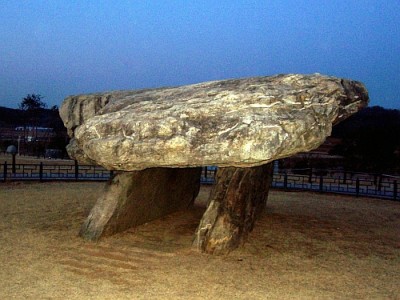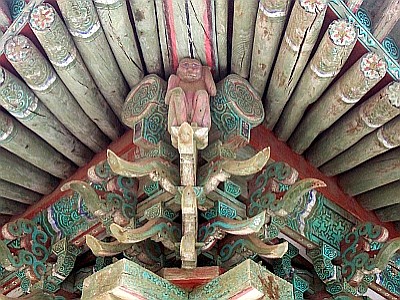
South Korea
Ganghwa island![[Unesco]](/images/unesco-logo.gif)
Ganghwa is an island located in the west of Seoul. This is one of three major sites of dolmens of South Korea listed as Unesco world heritage. It is on this island that the king took refuge during the Mongol invasion of the 13th century. He ordered the engraving of the Tripitaka (Buddhist texts known as Three Baskets) which will later be transferred to Haeinsa temple. In the 17th century, another Korean king took refuge there during the Manchu invasion. Finally, the island was invaded in 1866 during the French expedition in retaliation for the killing of missionary priests.
Dolmen Goindol
Yes ! there are dolmens in Korea. Did you expect this ? actually there are even 40% of the megaliths of the planet ! The latter with its 7 m (7.7 yards) long and 2.60 m (2.8 yards) high is the largest of the country. It dates back to the Bronze Age. How about a photography by night ?...

On the site, one can also observe other reproductions of megaliths (including Easter Island statue) and huts.
Jeongdeungsa temple
The temple is surrounded by a fortress from the 18th century that was built on the site of the first fortress of Korea, that according to legend, was built by the three sons of Dangun (see Mount Manisan below). The temple dates back to the 4th century and it is here that 81,340 wooden plates of the Tripitaka were engraved in the 13th century. Unique in Korea, the sculptures of monkeys under the edges of the main hall.

Bomunsa temple
It is located on another small island, Seongmodo, in the west of the main island. The history of this temple is linked to the discovery of 23 "statues" in the nets of a fisherman who gave them to the monks after a dream in which he had the revelation they were Buddhist statues. This scene is depicted on one walls of the temple. In the height, there is a bas-relief of 10 m (11 yards) high, representing the bodhisattva of compassion, Avalokitesvara (in Sanskrit).
Mount Manisan
Mount Manisan is the highest mountain on the island. At the top, we find the altar Chamseongdan that would have been erected by
Dangun (or Tangun),
the founder of Korea. It is always a sacred place for the faithful (not that numerous) of daejonggyo (or taejonggyo) which is arguably the oldest religion of Korea,
based on the cult of Dangun. ![]() Legend of Dangun
Legend of Dangun
In these ancient times ruled the King of Heaven Hwanin. One day he surprised his son Hwanung in full contemplation of the earthly world,
and, very anxious, he called him out. Hwanung told him that the fate of humans who daily become mired in lies and
deceit mattered him, and he expressed his wish to descend to earth to help them. Reluctantly but full of paternal pride, Hwanin granted him his wish and
sent him on earth, specifically to the top of Mount Baekdu (formerly known as Taebaek), accompanied by a retinue of 3,000 servants. With the help of his
ministers of the winds, clouds and rains, Hwanung founded the City of Sinsi (Divine city) and began to educate the people and to teach basic
agriculture and medicine. One day, two animals, a tiger and a bear, appeared before Hwanung with the following query : they wanted to become human.
Hwanung warned them against the difficulty of the test they would have to overcome, but facing their obstinacy, he decided to give them each 20 cloves of garlic
and mugwort (Artemisia capillaris) along with the following instructions : "Pray to the gods for a hundred days, locked in the dark, and feed you
only with these foods". The two animals locked themselves in a cave and the test began. After twenty days, the tiger could not stand it anymore and gave out its dream
to become a man and thus fled the cave. The bear, however, endured the test to the end and got its reward by being transformed into a beautiful woman.
Hwanung gave her the name of Ungnyeo. A new hope sprang up in her : it was to have her own child one day. Moved by her prayers, Hwanung married her and some time
after Ungnyeo gave birth to a boy they named Dangun. Thus he was to become the first ancestor of the Korean people. The Korean calendar also began in 2,333 B.C.
(supposed date of birth of Dangun) until the late 19th century.
After inheriting the throne from his father, Dangun built the city of Pyongyang, which became the capital of this new kingdom, called Joseon. The legend, which dates back
to the 13th century, relates that the beloved Dangun (as always concerned about the welfare of his people) would have withdrawn to the mountains to become an immortal spirit and
would be "disembodied" in a mountain god at the age of 1,908.... Thus in shamanism, Dangun on the end of his life, when he was assisted by a tiger and two
servants, has been associated with Sansin (or Sanshin), the spirit of the mountain.
Note : the path that leads to the summit in 1 hour is easy to access, but be careful if too much snow for going downhill...
